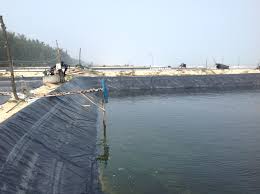Understanding HDPE Geomembranes: Applications, Benefits

HDPE (High-Density Polyethylene) geomembranes are widely recognized as one of the most effective materials for containment and environmental protection. These synthetic liners are extensively used in various industries, offering durability, chemical resistance, and flexibility. This blog explores the key aspects of HDPE geo membrane, including their applications, benefits, installation, and maintenance practices.
What Are HDPE Geomembranes?
HDPE geo membranes are impermeable liners made from high-density polyethylene. Known for their robustness and versatility, these membranes serve as barriers to prevent liquid or gas migration in containment systems. They are manufactured through extrusion processes, which produce a uniform and seamless material.
Characteristics of HDPE Geomembranes:
- Thickness: Commonly ranges from 0.5 mm to 3.0 mm.
- Flexibility: Allows for easy installation over uneven surfaces.
- Resistance: Offers excellent resistance to UV rays, chemicals, and environmental stress.
- Longevity: Can last decades when properly installed and maintained.
Key Applications of HDPE Geomembranes
HDPE geo membranes find applications across multiple sectors due to their adaptability and durability. Below are some of their prominent uses:
1. Landfills and Waste Management
In waste containment systems, HDPE geomembranes are essential for lining landfills. They act as barriers to prevent leachate from contaminating groundwater.
2. Mining Industry
Used in tailings ponds, heap leach pads, and containment systems, HDPE geomembranes provide protection against leakage of hazardous materials.
3. Water Reservoirs and Aquaculture
In water management, HDPE geo membranes are used to line reservoirs, canals, and ponds. They prevent water seepage and ensure efficient storage.
4. Agriculture
Farmers use HDPE geomembranes to line irrigation canals and water storage tanks, ensuring minimal water loss.
5. Energy Sector
The material is used in secondary containment systems around oil tanks to prevent spillage.
6. Environmental Protection
In wetland restoration and wastewater treatment plants, HDPE geomembranes are used to isolate and manage contaminants.
Advantages of HDPE Geomembranes
The widespread adoption of HDPE geo membranes is driven by several benefits that make them a preferred choice for containment systems.
1. Exceptional Durability
HDPE geomembranes withstand harsh environments, including extreme temperatures, UV exposure, and chemical attacks. This makes them ideal for long-term applications.
2. Cost-Effective
Despite their superior performance, HDPE geomembranes offer an economical solution due to their low maintenance requirements and longevity.
3. Eco-Friendly
HDPE is a recyclable material. Using these geomembranes contributes to sustainable practices by reducing environmental contamination.
4. Flexibility in Design
These liners are available in various thicknesses and sizes, catering to diverse project requirements. They can be fabricated into panels for ease of installation.
5. Resistance to Chemicals
HDPE geo membranes are resistant to a wide range of chemicals, including acids, alkalis, and hydrocarbons. This property ensures their reliability in industrial and hazardous environments.
Installation Process of HDPE Geomembranes
Proper installation of HDPE geo membrane is critical to their performance. Here is an overview of the key steps involved:
1. Site Preparation
The site must be cleared of debris, sharp objects, and irregularities. A smooth surface ensures the liner’s integrity.
2. Material Selection
Choose the appropriate thickness and specifications of HDPE geomembrane based on the project’s needs.
3. Deployment
The geomembrane rolls are carefully unrolled and positioned. Overlapping sections are arranged to prepare for welding.
4. Seaming and Welding
Seams are welded using thermal or extrusion methods. Quality control checks, such as air pressure testing, are performed to ensure a secure seal.
5. Anchoring
The edges of the liner are anchored in trenches or secured with weights to prevent displacement.
6. Inspection and Testing
Comprehensive testing ensures the liner’s integrity. Leak detection systems may also be installed for ongoing monitoring.
Maintenance and Monitoring
To maximize the lifespan of HDPE geo membranes, regular maintenance and monitoring are essential. Below are some best practices:
1. Periodic Inspections
Regularly inspect the geomembrane for signs of damage, such as punctures or tears. Address issues promptly to prevent leaks.
2. Cleaning
Keep the liner free of debris and sediment to maintain its functionality.
3. Monitoring Systems
Install leak detection systems for continuous monitoring in critical applications like landfills and hazardous waste containment.
4. Repairs
Use patches and welding techniques to repair any damages. Ensure proper adhesion and sealing to restore the liner’s integrity.
Comparison with Other Geomembranes
While HDPE geo membranes are highly effective, it is helpful to compare them with other materials to understand their unique advantages:
| Property | HDPE | PVC | EPDM |
|---|---|---|---|
| Durability | High | Moderate | High |
| Chemical Resistance | Excellent | Good | Moderate |
| Cost | Economical | Higher | Moderate |
| UV Resistance | Excellent | Poor | Good |
| Flexibility | Moderate | High | High |
Innovations and Future Trends
Advancements in manufacturing techniques and materials science continue to improve HDPE geomembranes. Some emerging trends include:
1. Enhanced Durability
Research into additives and coatings is enhancing UV resistance and increasing the lifespan of HDPE geo membranes.
2. Sustainable Solutions
Efforts are underway to make HDPE geomembranes more ecofriendly by using recycled materials and developing biodegradable alternatives.
3. Smart Geomembranes
Integration with sensors for real-time monitoring is gaining traction, offering immediate alerts in case of leaks or damage.
Conclusion
HDPE geo membrane are an indispensable tool for containment and environmental protection. Their durability, cost-effectiveness, and versatility make them suitable for diverse applications, from waste management to water conservation. By understanding their benefits, proper installation techniques, and maintenance practices, industries can harness the full potential of HDPE geo membranes, ensuring long-lasting and reliable performance.
